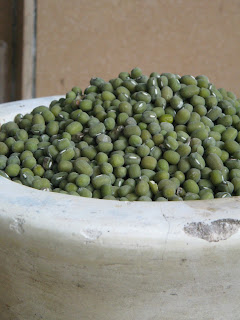I attended Ash Wednesday mass at my kids' school, and as expected, the homily was lecture-like. Since the captive audience was composed mainly of elementary and high school students, the lesson for the day was very basic, delving on the rules for Lent.
Far from being boring, I found the lecture enlightening. I attended non-sectarian schools my entire life, and even though I was active in our local parish church from Kindergarten up to high school graduation, there were many things missing in my haphazard Catholic education, which came from unstructured, irregular catechism classes.
One of the revelations for me was that in the Philippines all Fridays throughout the year are Lenten days, and so are subject to abstinence from meat. So now I understand why there is always monggo every Friday in every canteen, eatery and karinderia I've eaten, been to or passed by. I previously thought it is carrying a bit too far, outside Lent.
For monggo is the ultimate symbol of penance and abstinence. It is considered lowly, and is sold cheap, but like the bread and fish in the parable, it multiplies when cooked to feed countless mouths.
It is also very nutritious. Monggo stew is a hearty, filling one-pot meal that's good any day of the week. It has become a favorite that I actually consider it a treat to eat come Fridays.
This is how to cook monggo. Wash and drain the beans, then put in a large pot with water. Monggo beans is usually sold in packets of 250 grams. This needs about 3-4 liters of water for cooking, and is good for about a dozen, even more, people when cooked.Cover and bring to a boil for approximately one hour, checking regularly to add water as needed. When the beans are soft and have split or the green hulls have separated from the seeds, add preferred vegetables and/or leaves. Season to taste. Bring to a boil until the added vegetables have cooked as desired. Remove from heat.
Peel several cloves of garlic and crush with a flat, wooden ladle or the handle of a big knife. Peel a small onion and slice thinly. Wash 3-5 medium tomatoes and slice into quarters or smaller.
In a frying pan heat some oil, then saute the garlic in it, stirring until a bit brown. Add the onion, and fry until translucent. Mix in the tomatoes and stir. Let the tomatoes cook until wilted and soft. Transfer everything in the pan to the pot of cooked monggo, stirring well to incorporate. Ladle into a bowl and serve.
That is the basic way of cooking it, and from there it can be taken to a multitude of different directions. In Palawan I've eaten monggo with banana blossom cooked in gata. In Pangasinan we add bagoong and a thumb of peeled ginger to the cooking monggo, just like how we cook all our vegetables.
If using meats - fatty slices of pork or chopped chicken - they are added halfway through the cooking time of the beans. If meat is added in Pangasinan we season with salt or patis but not bagoong. When not using meat, since it's usually for Lenten Friday, we season with bagoong then add a piece of grilled bangus just before turning off the heat. Some people like adding crushed chicharon on top when ready to serve, though I don't favor it because I like chicharon crunchy, not waterlogged.
Outside of Lent I like adding left-over grilled meats - lechong manok, most frequently - to any stew. I even keep the bones for making soup stock. When using, I usually add the grilled meat right after cooking, and mix this into the stew.
Almost any kind of vegetable can be added to the stew. Ampalaya is the most common, probably to keep with the penitential theme. As is ampalaya leaves. We frequently combine ampalaya fruit, deseeded and sliced thinly, with malunggay leaves. A grand-aunt liked her stew with the local spinach. My in-laws added bagbagkong when in season.
Whatever mixture it is, it would be prudent to remember some things when eating monggo. Cook the beans thoroughly to avoid indigestion and even constipation. There is no need for pre-soaking. It would also be wise to serve it only during lunch. Store cooled leftovers in a clean, tight container in the ref and serve the next day reheated. When the leftover stew has formed little bubbles, throw it away.
And lastly, the best kind of beans for stewing is the one with tiny fuzz all over, like sprinkled with a fine dust. They cook to a thick soup.
Related Posts
The Three Forms of Monggo
Baeg
Black Bean Stew
Papait
Bagbagkong
Bataw
Sigarillas
Katuray



ReplyDeleteHello Kai, Lentils cooked the way we cook mungo is divine. I learned it from my Mexican friends and it comes in a variety of colors. Try it sometime. All the best for the season.
Oh yes, I've eaten lentil stew and it tasted so much like munggo! But I'm not about to swap our balatong for lentils, as they cost more than beef here by the kilo! There's yellow munggo, and red, too, on top of the green, so I can be colorful, as well. ;-)
ReplyDeleteOne of my favorite dishes in Mongo (I learned it with only one "g"). The way my grandmother and Mom made it was with lots of pork, some tomato sauces, the mung beans and some onions. I think I might even have some in the freezer! Ah, brings back good memories.
ReplyDeleteUm, that sounds like pork and beans!
ReplyDelete